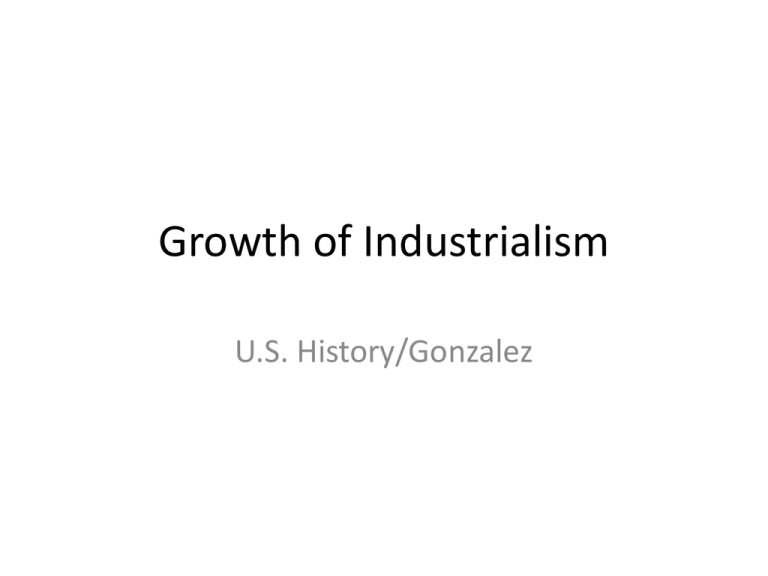Growth of Industrialism
advertisement

Growth of Industrialism U.S. History/Gonzalez Standards and Objectives • Standard • Objective: Students will be able to describe the factors contributing to and the impact of the rapid industrialization between 1865 and 1910. 2.2A Seamstresses working in a textile factory around the turn of the century 2.2A Seamstresses working a textile factory • Rise of Industrialism: a change of production from hand craftsmanship to machine manufacturing • Key factors in industrial growth – Natural resources for fueling factories • Oil, coal and iron – Improved transportation • 150,000 mi. or train tracks – Population moved from rural areas to urban centers – Government laissez-faire policy on business (no restrictions) Skyscraper built in New York City in 1901 2.2 B Invention and innovation • Many new inventions: Between 1860 and 1900, U.S. Patent office granted 676,000 patents to inventors of machines, techniques and tools. • Bessemer Process: the process of turning iron into steel was made easy and cost-effective. • Electricity: Samuel F.B Morse telegraph and Alexander G. Bell telephone transmitted speech over electrical wires. • Machines increase production: sewing machines and assembly lines John D. Rockefeller, founder of Standard Oil Company 2.2C Industrial Leaders • Industrial Giants: Owners of companies that became very prosperous became known in the United States. • John D. Rockefeller and Oil: controlled 90% of the oil industry. He argued that monopolizing the oil industry brought economic stability and high quality goods. • Andrew Carnegie and Steel: “rags to riches story” immigrated from Scotland and made his money using the Bessemer process to produce steel Cartoon from “Bosses of the Senate” from Puck magazine 2.2D Trusts and Government Corruption • Rise of Industrial Trusts: businesses combined competing companies into monstrous firms called trusts. In 1904, 319 industrial trust swallowed 5,300 independent manufactures. • Trusts Influence Government Affairs: owners of trust began to run for government offices. Trusts wanted little intervention from government in their businesses. • City corruption: Political machines gave gifts to families to gain political favors. Andrew Carnegie and a group of business leaders 2.2E Criticism and Defense of Big Business • People began to criticize big business because they controlled so much of the industry. Unequal distribution of wealth (material worth of 1% of population was greater than 99% combined) • Andrew Carnegie argued in the “Gospel of Wealth” that wealth was a sign of divine approval but that they needed to donate money to causes they believed in. Carnegie gave $350 million Steel workers in Andrew Carnegie’s steel mill in Homestead, Pennsylvania 2.2F: The Impact of Industrialism • Industrialization benefited the middle class – National wealth and income grew significantly during this time. – People were able to benefit from technological advances such as the telephone, automobiles, fresh produce and buy ready made clothes. – Dept. Stores created many jobs for people, clerical and sales. – People had jobs and were making money 2.2 F: The Impact of Industrialism • Life for Average Americans: – The majority of people during this time still used candle to light their homes. – Had no indoor plumbing or heating – ¼ of population owned property – 7% of people had high school diploma 2.2 F: The Impact of Industrialism • Industrial working conditions: – Men and women regularly worked 10 to 12 hour days. – Hot and unhealthy working conditions. • Hundreds of men killed while working next to molten steel • Thousands of women suffered permanent back injuries working in cramped conditions • Dehumanizing and demoralizing for assembly line workers who “became a hand—not a brain–not a soul—deadened into a part of a machine” Modern Times Coal miners, most of whom are boys, in Pennsylvania 2.2G: Change and Discrimination in the Work Force • Industrialism and Women: – Women’s role shifted significantly. Young women became secretaries and sales people in department stores. – Women got paid less about 50% less compared to a man. • Child Labor – 1.75 million child laborers (10-15 yrs) – Asthma from dust clouds, back deformities from hunching over all day. 2.2H: Organized Labor 2.2H: Organized Labor • Labor Unions Emerge: – Working conditions worsened and income disparity increased, laborers began organizing in unions with the hope that collectively they could influence big business. – Laborers wanted to secure an 8-hour workday, elimination of child labor and equal pay for men and women. • Business Response to Labor: – Business accused labor groups of “plotting a social revolution and the subversion of the American Republic” 2.2H Organized Labor • Union Victories: – Most industries set a maximum work hours and provided workers’ compensation for injuries. – 1912 child labor laws in 38 states had set minimum-age restrictions and health standards for industrial workplaces. 2.2I: Food Contamination and Muckrakers • The Meatpacking Industry – Upton Sinclair, The Jungle, described how industries, in Chicago, resorted to extremely unsanitary practices in order to keep up with production. – Examples: • spoiled and diseased pork was often dressed, packaged and sold as fresh meat. • Bologna sausage came from diseased cows with sawdust, dirt potato flour and spices. – As a result of publication, President Theodore Roosevelt pressed Congress to pass meat-inspection laws mainly because soldiers died from eating tainted meat. 2.2I: Food Contamination and Muckrakers • Muckrakers were group of writers that exposed ills in society like political corruption, suppresion of racial minorities, slum conditions and dishonest business practices. • There writings would bring future changes in how everything was done. (More government involvement) 2.2J: Toll on the Environment 2.2J: Toll on the Environment • Techniques used by businesses were devastating to the environment. – Hydraulic mining: using water to expose iron ore near the surface. – Clear-cutting: clearing whole sections of land at a time.





